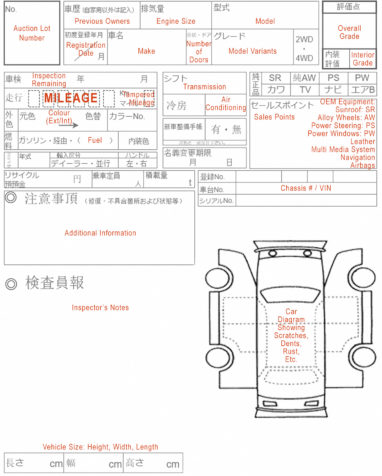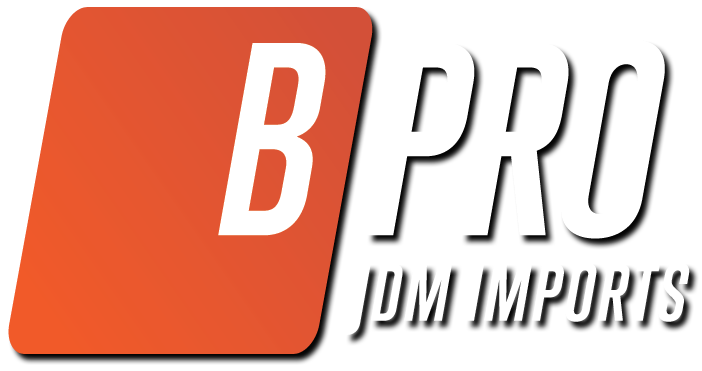The Japanese auction sheet represents the
detailed and uniform inspections
to vehicles when they are checked-in.
When a vehicle is checked into one of the auction houses across Japan, they have a standardized report detailing their condition – the auction sheet – from an independent party who has no benefit resulting from the sale of the vehicle. It greatly helps buyers from across Japan (and the world) accurately assess the car’s condition without being personally at the auction, and they trust the provided assessment.
Vehicle details including the production year and month, odometer reading, exterior and interior conditions, scratches, dents, repair marks, rust, and any specific details the inspectors could easily ascertain like presence of coilovers, aftermarket wheel makes and sizes, if there are leaks or weird engine noises are all written on the auction sheet.
Over 12 months old and has more than 30,000km but less than 60,000km.
Presence of only a few small dings with no need to repair.
More than 60,000km but less than 100,000km.
Could be considered a 5 if easily-fixed blemishes are fixed, like a few extra dings repaired fully through paintless dent repair, surface marks through buffing, or slight dirt / stain removed through cleaning.
Less than 150,000km.
May have some noticeable scratches, dents, small burns or torn areas. Signs of use, but above average. Fixable damage and doesn’t permanently affect the car’s value. Mechanically in good order.
Less than 200,000km.
May have a number of noticeable scratches, dents, burns or torn areas. Average example of a used car. Damage may require repair and if unchecked may start to permanently affect the car’s value, like rust repair. Fairly good mechanically, but may have a couple of small issues like a single power window not working or a small engine oil leak.
No km limit, and have large, obvious areas in need of repair to a significant portion of the vehicle. May have major dents and scratches, corrosion, broken seats or reupholstering required. There maybe unknown noises from the engine and major oil leaks.
Very little commercial value and/or of very poor quality.
History of water damage or use of a fire extinguisher
History of repair or replacement. This could be due to the permanent installation of a body kit, original or OEM reproduction panels replaced for cosmetic reasons, or an accident.
This grade masks what the current car’s condition actually is – it could be a 3, 3.5 or even 4 overall condition, but the repair or replacement makes it non-original. With popular cars becoming rarer, R grades could be an option for some. Having the auction sheet translated is important, as it indicates which panels have been replaced (XX), and may indicate damage to core or rad supports, cross-members, pillars or the floor. With a second inspection we can sometimes get additional pictures of the affected areas.
New or near-new interior. May have some small dirt marks, but can be easily cleaned.
Like-new interior. Some minor discoloration or wear. May have one or two small stains, burn-holes or screw marks overall.
Signs of average use. Interior may be dirty, but cleanable. May have a few noticeable stains, burn marks, or scratches. There may be some minor cracking or bulging of the dashboard, with the auction sheet translation indicating which conditions may be present.
Excess wear, including wearing thin of upholstery, sagging headliner, larger deformations of the dash, multiple cigarette burns, rips, tears or cracks. Interior is generally complete, but in need of repair.
Permanent and excess damage, with large cracks or holes cut into the dashboard or other areas, missing interior pieces, may have water damage and obvious odours.
About the size of a thumbnail
About the size of an open hand
Very large, more than the size of an open hand
Scratches
Dents
Dents with scratches
Rust / Corrosion
Dimples
X – Needs repair / XX – Repaired
Cracks
Chip on glass
Wavy finish: 1 – Well finished but slight wave; 2 – Some putty streaks or waves but the repair is still good; 3 – Obvious unevenness and the repair is not good.
To provide additional context for the condition of the car, a diagram on the auction sheet is marked with any defects found.
The letter indicates what kind of defect it is, and the number how big. It could also be drawn on the diagram with a line or shape of the damage.
Near the top-left corner of the auction sheet is usually a set of numbers in the format of Letter # # / #. This corresponds to the year and month of first registration of the vehicle.
This is important, as it is one of the main factors in determining if a vehicle is legal for importation – for most of Canada it has to be 15 years old, and for Quebec, PEI and the USA it has to be 25 years old to the month from the date of manufacture.
For most cars, the month of manufacture and month of first registration are the same, however for some unique or expensive cars that might have sat on a dealership lot for a bit, these might be different. You can use our auction tool to find out the build date of a vehicle.
Information on the Japanese calendar and era names can be found on Wikipedia. For most purposes what you need to know is:
H (Heisei) began in 1989. For cars to be legal in Canada in 2021, you would need to find one from at least 2006, which is H18. 2005 is H17, 2004 is H16, etc. For JDM cars to be legal in Quebec, PEI or the USA, you would need to find one that is a 1996 or older, which is H8, 1995 is H7, 1994 is H6, etc.
Due in part to the mandatory Shaken inspections, Japan also has a good system for keeping track of the mileage of a vehicle.
Japan also has an active tuner culture. Most vehicles have clusters that are limited to 180kph, but tuning divisions like TRD and Nismo have aftermarket clusters that go beyond that limitation, and are often swapped in. If the mileage recorded when the car is consigned to auction doesn’t match the records, an asterisk ( * ) is placed next to the mileage, indicating the actual mileage is unknown.
Sometimes there is vehicle history described in the notes that could approximate the actual mileage and in some cases, this change has been well documented. In this case, inspectors place a dollar sign ( $ ) next to the mileage.


We would be happy to import a JDM vehicle for you! Please contact us to discuss the details of importing from Japan to Canada with B-Pro Auto, or to ask any other questions you may have! We would love to start the conversation with you.
Phone: 403-481-1065